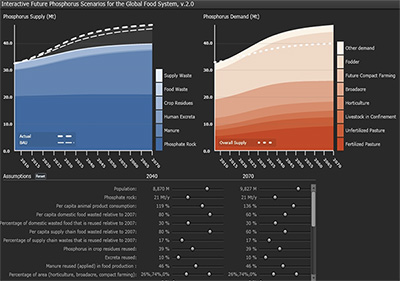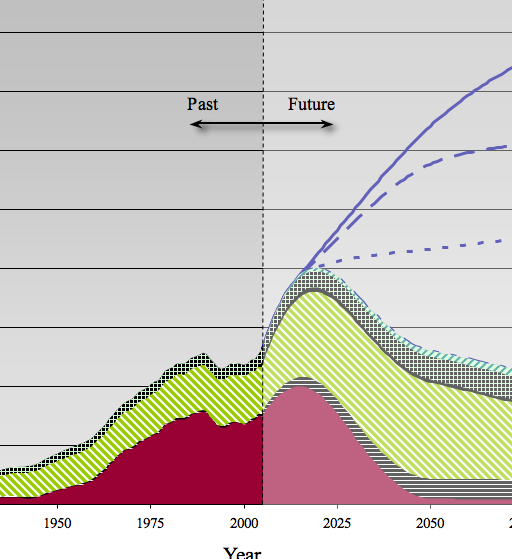
Achieving global phosphorus security requires an integrated approach exploring potential demand reduction as well as recycling opportunities. This implies recovering phosphorus from multiple sources, such as food waste, manure and excreta, as well as exploring novel opportunities to reduce the long-term demand for phosphorus in food production such as changing diets. However there is a lack of stakeholder and scientific consensus around priority measures.
These interactive scenarios present a significant opportunity to:
- understand future implications if we continue on the current phosphorus use trajectory
- explore in real-time the impact of a suite of future possibilities and sustainability options (like recycling human excreta or increasing efficiency in crop production) to meet long-term phosphorus demand
- provide a real-time decision-support tool for deliberation among policy-makers, scientists, industry, the community and other key stakeholders to collaboratively identify priority options.
While version 1.1 presents an excellent basis for a first scenario exploration, version 2 will aim to overcome current limitations associated with input data quality, limited interactivity with respect to feedback and lack of linkages to other resources, and thus ensure that stakeholders can engage with the scenarios in a meaningful way.

The interactive future phosphorus scenarios v1.1 were developed both for the Global and national (Australian) contexts. For the National (Australian) model, it was not possible to simply scale down the global to the national level. This is firstly because there is an absolute population in the global model, and an absolute amount of phosphate rock and other resources. In the national model, decisions can be made regarding population fed (for example, Australia currently feeds 60-70 million people), and domestic production of phosphate versus imports. The Australian model was therefore built based on domestic land use and land availability and domestic phosphate sources (phosphate rock, manure, crop residues etc). Population that can be fed becomes an output rather than input assumption (the latter is the case for the Global model).
Unlike the Australian Phosphorus Flows model, which takes averages across agricultural and livestock sectors, the interactive future scenarios model breaks agricultural down into the farming categories of horticulture, broadacre and ‘future compact farming’. These have different characteristics with respect to phosphorus, in terms of fertiliser inputs and productivity expressed per unit of land area. ‘Future compact farming’ refers to any efficient, sustainable crop or food production system that has a high productivity per unit of land. One current example of such a system includes ‘Quorn’, a high-protein, meat-free, soy-free product specifically developed in response to pressures on the global food system to meet future food demand. Similarly, livestock has been broken down into three production categories: pastures (fertilised), remote cattle stations (unfertilized northern grazing systems) and feedlots (grain and supplement-fed). Each have specific phosphorus inputs and productivity levels expressed per unit of land area.
If you are interested in becoming a funding partner for v2.0, please contact:
- Tina.Neset@liu.se (Global interactive phosphorus scenarios)
- Dana.Cordell@uts.edu.au or Stuart.White@uts.edu.au (National/Australian interactive phosphorus scenarios)
Further resources:
Preferred future phosphorus scenarios: A framework for meeting long-term phosphorus needs for global food demand, Cordell et al (2009b), IWA Publishing.
Exploring alternative phosphorus futures using visualization: the interactive global phosphorus scenario tool v1.1. Neset, T-S, Cordell, D., vanRiper, F., Mohr, S & White, S. Forthcoming.
Adapting to future phosphorus scarcity: investigating potential sustainable phosphorus measures and strategies, Phase II of the Australian Sustainable Phosphorus Futures project, prepared by Institute for Sustainable Futures, University of Technology Sydney, for the Rural Industries Research and Development Corporation, Australian Government, Canberra. Cordell, D., Mikhailovich, N., Mohr, S., Jacobs, B. & White, S. (2014).
Analysis of phosphorus flows through the Australian food production and consumption system, Phase I of the Australian Sustainable Phosphorus Futures, Institute for Sustainable Futures, University of Technology Sydney, prepared for Rural Industries Research & Development Corporation, Australian Government, Canberra, pp.57. Cordell, D., Jackson, M., Boronyak, L., Cooper, C., Mohr, S., Moore, D. & White, S (2014),
